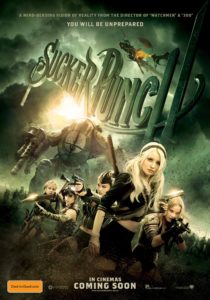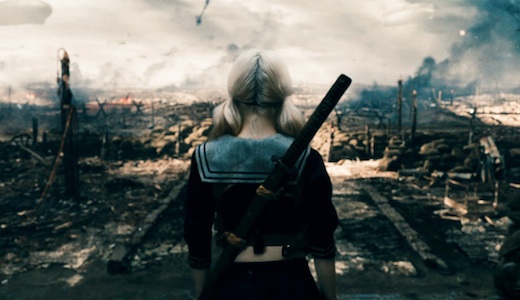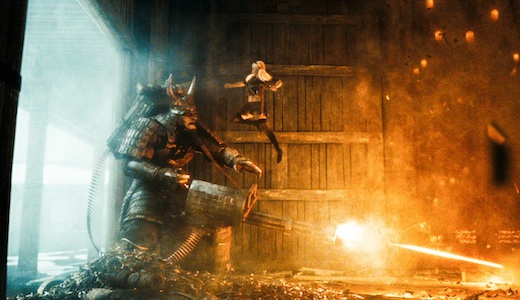 After successfully, although some would argue needlessly, updating George A. Romero’s Dawn of the Dead with his own version in 2004, writer/director gained instant cult cache. Snyder used this newfound status to bring Frank Miller’s visually distinctive graphic novel 300 to the big screen, and in doing so established himself as a visual filmmaker with a penchant for breathing life into the static image. Snyder solidified this reputation by achieving the seemingly impossible and finally realising Alan Moore’s epic comic Watchmen as a major Hollywood film, gaining praise from critics, fans and audiences alike. After a brief change of pace with the animated adaptation of Kathryn Lasky’s Legend of the Guardians: The Owls of Ga’Hoole, Snyder has chosen to direct his own original creation for the screen.
After successfully, although some would argue needlessly, updating George A. Romero’s Dawn of the Dead with his own version in 2004, writer/director gained instant cult cache. Snyder used this newfound status to bring Frank Miller’s visually distinctive graphic novel 300 to the big screen, and in doing so established himself as a visual filmmaker with a penchant for breathing life into the static image. Snyder solidified this reputation by achieving the seemingly impossible and finally realising Alan Moore’s epic comic Watchmen as a major Hollywood film, gaining praise from critics, fans and audiences alike. After a brief change of pace with the animated adaptation of Kathryn Lasky’s Legend of the Guardians: The Owls of Ga’Hoole, Snyder has chosen to direct his own original creation for the screen.
After a young girl, Baby Doll (Emily Browning, The Uninvited) is thrown into a mental asylum following the death of her mother and accidental murder of her younger sister, the walls of reality begin to break down. Baby Doll retreats into an alternate reality, where her fellow inmates Sweet Pea (Abbie Cornish, Limitless), Rocket (Jena Malone, The Messenger), Blondie (Vanessa Hudgens, High School Musical) and Amber (Jamie Chung, Grown Ups) are dancers in a seedy nightclub, under the tutelage of Dr. Vera Gorski (Carla Gugino, Faster). Yet even this reality proves too painful, and Baby Doll finds solace in a more violent and twisted place, filled with mechas, giant samurai and warmongering, and where she is aided by Wise Man (Scott Glenn, Secretariat). Through this world, she seeks to find not only freedom, but her own salvation.
Sucker Punch isn’t so much a film as a collage of influences. Snyder has a long list of things that he considers to be cool, and throughout the 110 minutes that make up the Sucker Punch compilation, he crams them all in. Snyder understands that each of these intertextual references are hip: he’s seen badass Nazis, chicks in schoolgirl uniforms, giant samurai, Japanese temples and gun-toting mecha in all of his favourite movies and comic books. Yet he doesn’t understand why they are cool, or more specifically, why they were cool in their original contexts. By lifting each of these elements out of their own cinematic time and place, it is not just an act of post-modern mashup but a complete corruption and wholesale appropriation of a way of storytelling that Snyder is yet to comprehend. This may be demonstrated most aptly by his choice of soundtrack, a series of terrible covers of the likes of Queen, the Pixies, The Smiths, Björk and (forgive him, he knows not what he does) The Beatles. Like all other pop-cultural elements to the film, each of these tunes were counter-culture moments that struck a chord with the alternative youth. For Snyder, they are simply more toys to play with. Worse yet, Snyder probably thinks that he is telling a tale of great female liberation, with the doe-eyed Baby Doll and her tough-chick sidekicks growing a pair and sticking it to the man. Instead, he is living out his own set of fantasies, for this is what Sucker Punch is: one long male fantasy tarted up and paraded around as girls fighting back. Compared with Ripley or Sarah Conner, these are merely lipstick heroines.
Stylistically, Snyder treads the same slow-motion ground that has served him well since 300. Snyder has often been accused of telling a story by simply shooting it at a faster number of frames per second, and there is nothing in this latest venture that will dissuade detractors from that notion. There is an early funeral sequence that appears to have been lifted wholesale from Watchmen, so it is good to know that it is not simply other people’s styles that Snyder borrows from. Each of the female leads plays their part competently, although they are given limited depth to work with. Australians Browning and Cornish are given the most screen-time, although once inside Baby Doll’s more war-prone fantasies, it doesn’t really matter who is on screen. All we really get to follow is a flash of flesh, a bit of up-skirt action, more explosions that we could reasonably count and guns, lots of guns. For the core audience, we suspect that this will do just fine, especially if you thought Battle: Los Angeles just “needed more chicks”. Snyder may be served best by returning to other people’s works for inspiration, and knowledge that he is helming the forthcoming Superman: Man of Steel is now likely to have fanboys shaking in their sneakers.

Sucker Punch is released on April 7, 2011 in Australia by Roadshow Films.






No Responses